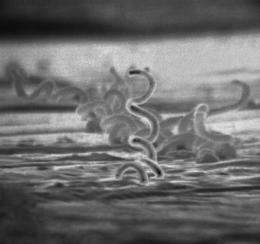
Genome sequencing has shed light on the re-emergence of the bacterium that causes yaws, a neglected tropical disease of the skin, bones and joints. The re-emergence followed a mass drug administration (MDA) campaign that aimed to eliminate the disease in Papua New Guinea.
Researchers at the Wellcome Sanger Institute, the London School of Hygiene & Tropical Medicine, the Fight Aids and Infections Disease Foundation, Spain, the University of Washington and the University of Papua New Guinea, report their findings today in Lancet Microbe. The results will influence the global elimination strategy for this disease.
Yaws, caused by the bacterium Treponema pallidum subspecies pertenue (TPP), can cause chronic disfigurement and disability. Most commonly affecting children, infection with the bacteria results in stigmatising and debilitating ulcers. Despite global efforts, yaws remains common in tropical areas in some of the world’s poorest countries, affecting millions of people. The World Health Organisation (WHO) is currently carrying out campaigns to eradicate yaws using Mass Drug Administration (MDA) of the antibiotic, azithromycin.
An MDA campaign on Lihir Island, Papua New Guinea, in 2013 reached 83 percent of the population (15-18,000 people) and was initially successful, dramatically reducing the incidence of the disease. But after two years, cases of the disease starting increasing. Molecular testing showed the bacteria were of a single type, however it was unclear if the re-emergence had a single source, or several. In addition, a small proportion of the bacteria were found to be resistant to azithromycin, the first time any such resistance had been seen.
In this new study, Sanger researchers sequenced the genomes of bacteria from 20 swab samples taken during the follow up of the MDA campaign in Lihir. The aim was to further understand the re-emergence following the MDA and inform future strategies.
Comparing the DNA sequences of the TPP bacteria, the team constructed phylogenetic ‘family’ trees to map their evolution. DNA sequences change over time at a constant rate as organisms evolve, and so it is possible to determine the relatedness of individual samples and relate that back to the patient and possible routes of infection. They found that, rather than re-emergence being due to a single source, missed case, or reintroduction, the re-emergence of cases after MDA was actually caused by at least three distinct TPP lineages. The most likely explanation for this is that these were caused by latent infections in people, without symptoms, who didn’t receive the treatment. This has important implications for disease control, leading the researchers to recommend employing strategies to maximise MDA population coverage to reduce the number of people who are missed by these treatments who may have latent infections. They also recommend intensive post-MDA surveillance for detection of “the last yaws cases” and to control onward transmission of new infections.
Of the three lineages linked to the re-emergence, one became resistant to azithromycin during the study. To study this antibiotic resistance, the team combined the genomic data with epidemiological data about the movement and interactions of people in the region. This showed that resistance to azithromycin can evolve and spread rapidly in TPP. The authors recommend careful monitoring following an MDA to enable the rapid detection of azithromycin resistance that could compromise MDA campaigns. They also suggest considering alternative treatments for cases detected post-MDA, particularly where diagnostic testing for resistance is unavailable, since resistance is subsequently more likely to be present in the bacterial population.
Dr. Mathew Beale, first author of the study from the Wellcome Sanger Institute, said: “Even though an impressive 83 percent of the population were reached with antibiotic treatment initially, there were several instances of re-emergence of the bacteria. The development of antibiotic resistance is worrying, but the fact that it only occurred once after a mass drug administration is positive news. We still need to be very concerned about resistance, but it may be possible to manage it. Our results have big implications for how yaws elimination campaigns are run—we can recommend high treatment coverage initially and there needs to be careful surveillance and follow up to detect and swiftly treat any re-emergence, to prevent the bacteria spreading.”
Dr. Michael Marks, senior author of the paper at London School of Hygiene & Tropical Medicine, said: “Yaws is one of many neglected tropical diseases, which combined affect around one billion people—usually in low- and middle-income countries. They are often diseases of poverty, affecting rural communities without access to sanitation and basic healthcare. WHO has laid out a new roadmap for the control, elimination and, in the case of yaws, eradicating these conditions over the coming decade.”
Dr. Oriol Mitjà, senior author of the paper at Lihir Medical Center, Papua New Guinea and the Fight Aids and Infections Disease Foundation, said: “While yaws doesn’t kill, it causes significant disease in thousands of children around the world. Yet it is easily treatable. Following up on treatment trials is vital—we need to know where and why the bacteria are re-emerging. The results from this study are influencing the next steps and approaches we take to eradicate this disease.”
Professor Nicholas Thomson, senior author of the paper based at the Wellcome Sanger Institute and the London School of Hygiene & Tropical Medicine, said: “The resolution afforded by genome sequencing to track agents of infectious diseases is vital for our efforts to control and, eventually, to eliminate them. It can help us understand how and where bacteria or other pathogens are spreading between people, as well as how they respond genetically to our attempts to control them. Hence, monitoring for drug resistance is also essential to defeat these diseases. The information can help target interventions and treatments so they have the most effect.”
Wellcome Trust Sanger Institute

